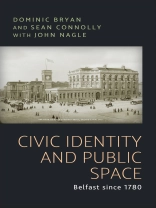Civic identity and public space, focussing on Belfast, and bringing together the work of a historian and two social scientists, offers a new perspective on the sometimes lethal conflicts over parades, flags and other issues that continue to disrupt political life in Northern Ireland. It examines the emergence during the nineteenth century of the concept of public space and the development of new strategies for its regulation, the establishment, the new conditions created by the emergence in 1920 of a Northern Ireland state, of a near monopoly of public space enjoyed by Protestants and unionists, and the break down of that monopoly in more recent decades. Today policy makers and politicians struggle to devise a strategy for the management of public space in a divided city, while endeavouring to promote a new sense of civic identity that will transcend long-standing sectarian and political divisions.
विषयसूची
Introduction
Chapter 1 The origins of public space
Chapter 2 Lord Donegall’s town
Chapter 3 The making of a municipal culture
Chapter 4 Freedom and order
Chapter 5 Public space and civil conflict
Chapter 6 Public space and the Protestant state
Chapter 7 New directions? The 1960s
Chapter 8 Violence and carnival: renegotiating public space 1970-2008
Chapter 9 Shared space or divided future?
Conclusion Public space – past lessons and future strategies
Index
लेखक के बारे में
Dominic Bryan is Reader in Anthropology at the Queen’s University, Belfast
S.J. Connolly is Emeritus Professor of Irish History at the Queen’s University Belfast
John Nagle is Reader in Sociology at the University of Aberdeen












